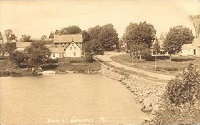

Aetna was renamed Etna
Alton 1844
Argyle 1839
Bangor (Kenduskee Plantation) 1791
Bradford (Blakeburg Plantation) 1831
Bradley (T4, Old Indian Purchase) 1835
Brewer 1812
Burlington was incorporated March 8, 1832, the 302nd town in Maine. Access to the area was up the Passadumkeag River from the Penobscot River. Settlement began in 1823, 1824 by Trustrum Hurd Jr., and the area became known as Hurd's Ridge. Lumbering and farming were the means of support. Names of the settlers were Barker, Bowers, Bradbury, Coffin, Costigan, Davis, Dockendorff, Edes, Folsom, Fox, Gonyer, Houghton, Hoyt, Hurd, Jipson, Libby, Lord, McCorrison, Moore, Neal, Page, Peasley, Peavey, Philbrick, Porter, Richardson, Scammon, Shorey, Sibley, Stickney, Taylor, Tripp, Turner, White, Woodman, and others.
Carmel 1811
Carrol Plantation # 6, R2 (1845 1937)
Charleston (was New Charleston) 1827
Chester was first known as Township Number One, Range 8. Chester was incorporated Feb 26, 1834. It is located on the west bank of the Penobscot River opposite the towns of Lincoln and Winn, 56 miles northeast of Bangor. In 1837, there were 323 people in Chester. The census records for 1870 and 1880 list 350 and 362 people. Common surnames in the town prior to 1900 include Adams, Archer, Bailey, Beatham, Berry, Booker, Brown, Chesley, Coombs, Cram, Davis, Faloon, Farrington, Fleming, Glidden, Gordon, Hall, Haynes, Ireland, Jordan, Kimball, Lancaster, Libby, Nichols, Reed, Runnells, Savage, Scott, Shaw, Smith, Spencer, Stratton, Tash, Twist, Whitney, White, and Wyman. Chester sent 32 men to the Civil War of whom 11 were lost.
Clifton was settled in 1812, and was originally called Jarvis Gore. It was incorporated as Jarvis Gore on 7 Aug 1848. Changed name to Clifton on 9 Jun 1849.
Corinna 1816
Corinth 1811
Dexter 1816
Dixmont 1807
Drew Plantation (1921- 1934)
Dutton Plantation No. 1, R3 (1822 1837) Changed to Glenburn
East Millinocket - meaning East of "Many Islands" in the language of the Abenakis, lies on the northern side of the West Branch of the Penobscot River, two miles above the land of Nicatou, now known as Medway.
Quick action by the legislature resulted in the incorporation of East Millinocket as a town on Feb 21, 1907. The terms of incorporation, by limiting the towns boundaries to the northeastern half of Township A, Range 7 of Penobscot County, tended to give it a triangular appearance and less than half the acreage of a regulation township. The inhabitable area was later further reduced by the flowages created by the East Millinocket and Dolby dams. The first step to make the legislative act operative was taken on April 11, 1907, when Justice Clinton C. Stevens, of Millinocket, called the first town meeting to order in Johnson's Drug Store on Main Street. Frank O. Pray was to serve the town in many capacities. At this meeting the following men were elected to serve as the towns first officials.
Town Clerk - Charles J Gosnell
Selectmen, Assessors, & Overseers of the Poor - James H Mack, Guy S Baker, William A Johnson
Treasurer - Harry L Weymouth
Tax Collector - W T Ray, who was also appointed as head constable, possibly to forestall any difficulties arriving from his duty as collector.
School Committee Members - Harry H Haines, David O Nesbitt & Charles Gosnell
Road Commissioner - Beecher Colbath
Fire Wardens - H W Severance, Elmer W Prouty and & W S Hamm
Constables - D J Balanger, W T Pray & Charles Boynton
Surveyors of Wood, Bark and Lumber - Guy S Baker & Every Getchell
Sealer of Weights and Measures - William A Johnson
After these offices were sworn in by Justice George W Stearns of Millinocket, the meeting was then adjourned to the afternoon of April 13, 1907.
Eddington Plantation 1811
Edinburg (River Township # 1, R6) 1835
Enfield 1835, Treat's Track
Etna. Previous designations 4R2 NWP, Crosbytown, Bowdoin College Grant. Settled in 1807. Incorporated February 15, 1820 as Aetna the 156th town of Maine Name change almost immediately to Etna. Part set off to form part of Plymouth February 21, 1826. Part set off to Carmel February 19, 1866. Description obtained from "The Length and Breadth of Maine" by Stanley Bearce Attwood. Major body of water is Etna Pond.
Exeter 1811
 Garland was granted June 2, 1798 to Williams' College [No. 3, 5th
Range.] It was settled in 1802, by Joseph Garland for who the town was named,
and by Isaac Wheeler, and Josiah Bartlett. Hon. Levi Lincoln was one of the
purchasing proprietors; and hence, the plantation was called Lincolntown. The
lots were surveyed in 1805, by A. Strong. A church was first gathered here by
Rev. John Sawyer. Post Office established in 1818. (MS. Let. of Abner Sanborn.)
Source: Williamson, William D., The History of the State of Maine from Its First
Discovery, A.D. 1602, to The Separation, A.D. 1820, Inclusive, Hallowell:
Glazier, Masters & Co, 1832, p. 618.
Garland was granted June 2, 1798 to Williams' College [No. 3, 5th
Range.] It was settled in 1802, by Joseph Garland for who the town was named,
and by Isaac Wheeler, and Josiah Bartlett. Hon. Levi Lincoln was one of the
purchasing proprietors; and hence, the plantation was called Lincolntown. The
lots were surveyed in 1805, by A. Strong. A church was first gathered here by
Rev. John Sawyer. Post Office established in 1818. (MS. Let. of Abner Sanborn.)
Source: Williamson, William D., The History of the State of Maine from Its First
Discovery, A.D. 1602, to The Separation, A.D. 1820, Inclusive, Hallowell:
Glazier, Masters & Co, 1832, p. 618.
Settled in 1802 by Mr. Garland, from whom named, and Isaac Wheeler and Josiah Bartlett. Incorporated, 182d town, February 16, 1811. Leading industries: Lumber and shingles. Population, 677; polls, 246; estate, $364,136. Source: Coe, Harrie B., ed., Maine: Resources, Attractions, and Its People. A History, New York: The Lewis Historical Publishing Company, Inc., 1928, p. 896.
Glenburn formerly known as Dutton 1822
Greenbush 1834
Greenfield 1831
Hampden 1794
Herman 1814
Howland 1826
Holden 1852
Hudson formerly known as formerly Kirkland, 1825 Census 1850 , 1860 , 1870 , 1880
Jarvis Gore, a tract, name changed to Clifton in 1849. Special 1837 Census
Lowell was incorporated February 9, 1837 as Huntressville the 338th town of Maine. The name was changed to Lowell after Lowell Hayden first male child born in 1838. In 1842 Lowell annexed the Cold Stream Settlement from the town of Passadumkeag. The means of surpport of the towns people was farming, lumbering, and mill work. Names of the settlers were Applebee, Austin, Bowers, Bradbury, Buck, Cabel, Chandler, Champion, Chase, Clay, Coffin, Cummings, Curtis, Davis, Doane, Dolly, Douglas, Engstrom, Ewing, Fogg, Folsom, Fox, Gillispi, Gordan, Hayden, Huntress, Jipson, Littlefield, Lord, Lyons, McKenney, Moore, Myrick, Neal, Parker, Perkins, Pettengill, Porter, Preble, Priest, Shorey, Sibley, Thurlow, Thompson, Turner, Wakefield, Varney, and others.
Kenduskeag 1852
Kingman (McCrillis Plantation or Independence Plantation) (1873 1935)
Kirkland (Now Hudson) (1825 1855)
La Grange 1832
Lee 1832
Levant 1813
Lincoln 1829
Mattawamkeag is the location of an ancient Indian Village which
borrowed its name from the river at whose mouth it is located. The Mattawamkeag
River is the largest eastern branch of the Penobscot River. Its entrance is
clearly distinguishable in low water by large white gravel bar, hence the word
is most often translated as "A River with Many Rocks at It's Mouth." The name
was later translated to the town.
Mattawamkeag, the town, was
incorporated in 1860. It was formerly known as Township No. 1 East Indian
Purchase. White men came in about 1829 when Col Stanley built a log cabin or
shanty for the accomodation of men engaged in hauling supplies for the lumbermen
over the frozen roads of Penobscot ice. It was closed up during the summer
season and Stanley soon left for Houlton after selling his place to Milliken and
John Rollins. In 1829 the United State government started the Military Road to
Houlton and completed it as far as Mattawamkeag that year. In 1830 Capt. George
Waite, who had been hauling supplies to lumbermen, bought out Milliken and John
Rollins. George Waite purchased some land and built a frame house a little
farther above the creek.
In 1830 James Penley and George
Wallace of Old Town erected a hotel on the site of the early Mattawamkeag
stagehouse, then sold it to Thomas Pratt of Old Town; perhaps Ira Wadleigh owned
an interest in it.
In 1835 only 2 families remained, George Waite,
farmer, hotel owner and owner of teams, and James Thompson, carrier of the
Bangor and Houlton mail, probably the first to carry mail on the Bangor and
Houlton Road, who built the house know as the McDonald house, just north of
Libbey and Stratton store.
Henry David Thoreau passed through
Mattawamkeag in 1847 where the Houlton stagecoach stopped. Here Throeau found a
"substantial bridge" over the Mattawamkeag River.
Mattamiscontis 1839
Maxfield 1824
Medway was incorporated in 1875. Situated at the forks of the East and West Branch of the Penobscot rivers. The town was known as Nicatou (meaning, the forks). Early exploration by loggers who established camps in the area were well known. Settlement in the area was in the 1840s and 1850s with families such as Archer, Bagley, Barlow-Burleigh, Bartlett, Beathem, Boynton, Brewer, Caswell, Clark, Cox, Cram, Daisey, Davis, Day, Delano, DeWitt, Dickey, Farrington, Fiske, Fowler, Fowles, Glidden, Gordon, Hale, Hathaway, Howard, Kimball, Ladd, LaPointe, Leavitt, Lee, Lyons, MacKenzie, Magoon, Markie, McCauslin, McLaughlin, McLeod, Monroe, Moore, Murray, Nadeau, Powers, Priest, Reed, Spinney, Thompson, Trask, Twist, Vance, York, and many others ... Logmarks identified the logs of each logger. Similar to the earmarks of livestock, the Maine woodsmen marked their logs ....
Milford 1833
Millnocket 1901
Mount Chase, T5R6, was settled in 1838 and was a plantation until a town on 21 Mar 1864. It was named for a Chase who came as an agent for the state to prevent timber thieves. Thirteen years later, Thomas Myrick came and was followed by a relative, Ezra Myrick. They were followed by Francis Weeks, John Crommett, John Fisk & Daniel Bumpus. Mount Chase had 250 population in 1860, 262 in 1870 and 310 in 1880.
Newburg 1819
Newport 1814
New Charleston (now Charleston)
Old Town 1841
Orono 1806
Orrington 1788
Passadumkeag 1835
Patten is 74 miles from Bangor, Maine. Patten is bordered by Mount Chase, Crystal Plantation, Stacyville Plantation, Township 3, Range 7, Hersey and Sherman, Maine. It was settled about 1828 as Township 4, Range 6 and it was not until 16 Apr 1841, that it became a town. The 1840 US census for Aroostook County's T4R5 (now Crystal ME) was called Fisk'e Township, but this was more likely Fish's Township as it included most of the early settlers of Patten, Maine. Patten Academy was incorporated in 1846. Early settlers appear to have come from Lincoln, Maine and vicinity, although many of them were origally from NH. A group also appear from Palermo, Washington, Somerville, Windsor, China, and Jefferson, Maine towns. Another group appears from Sumner, Buckfield and Paris Area. Some appear from the Limerick, York County, Maine area. Source: History of Penobscot County
Census Settlers Polls 1840 41 ? 1850 470 ? 1860 659 142 1870 704 153 1880 716 193 1890 936 ? 1900 1172 ?
Prentis 1858
Plymouth 1826
Springfield 1834
Stetson was settled in 1800 and was incorporated in Jan of 1831.
Veazie 1852
Winn 1857
Woodville 1895
Copyright © 1996- The USGenWeb® Project, MEGenWeb, Penobscot County